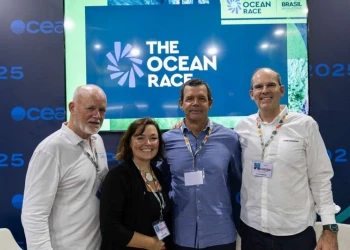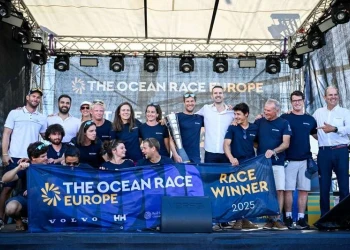
© Ronan Gladu / Biotherm / The Ocean Race
Sam Davies: how we kept the wheels on the wagon
Leg 3 wasn't easy for Biotherm, but an experienced crew, including Sam Davies, helped to bring the team home to Itajaí, despite all the challenges...
The badly damaged foil has been fixed, and Biotherm is starting to look race ready for the start of Leg 4 from Itajaí to Newport, Rhode Island, this Sunday, as the boat returned to the water in Itajaí this morning (Monday).
There are a few crew changes in play, due to be announced soon. After the drama of Leg 3, British sailor Sam Davies is one who will be taking a well-deserved step back from the fray.
Davies has had a long and successful career in ocean racing, yet Leg 3 still sprung plenty of surprises even for one so experienced in the offshore game. “It was brutal right from the start gun and the inshore course in Cape Town,” Davies recalls. The wind was gusting and lulling wildly as it fought to find a way over or around the huge mass of Table Mountain to the back of the city. Either 40 knots, or 0 knots, and very little in between. The shock loads on the IMOCA fleet were immense. Biotherm was hit by a huge gust. “We just did a massive nosedive and broke some gear on board,” says Davies. “It was BANG! Just crazy.”

The boat swiftly returned to the V&A Waterfront to sort some of the damage before they headed out into the wilds of the Southern Ocean. “So we’re playing catch up right from the start. But we knew it was a really long leg and and there was everything to play for. We had a good team spirit, a really good atmosphere onboard and ‘never give up’ feeling.
"We knew the boat is really young, and that we were going to have issues and technical problems. So we were kind of waiting for things to happen. But we had a team that could deal with that and not let it upset us. We're out there just learning the boat. And we had some crazy conditions right from the start - some strong wind stuff, some difficult waves and some mega nosedives again.”
Davies says skipper Paul Meilhat made some smart appointments with his crew choices for this toughest of legs. “Paul knew that we would have issues to deal with and he wanted people who wouldn't be affected by technical problems, who would accept that we're not always at 100 per cent. He knew it was going to be a hard leg and he picked a crew that he knew got on really well together and that he could manage really well. I think his team selection, the way he led us, and the fact that we are all really good friends and we all respect each other as sailors, all those things made the team work really well together.”

The teamwork would be tested many times throughout the leg. “We had issues all the way, and some pretty big issues at times. It was in the middle of the South Pacific when we were hooning along and there was a massive bang. One of the bulkheads inside the boat just sheared. There's just cracks all the way through these massive long bulkheads. And so we just slow down and Paul and Anthony [Marchand] are really good with composites and laminating. They just don't even question that it's going to be an issue. They get their heads down, get the spare kit out and start sanding and laminating. They basically rebuilt a bulkhead in the middle of the Southern Ocean.”
Then there was Cape Horn. “Cape Horn is our Everest. It’s so remote in the world. If something happens to you there, it's pretty difficult to get rescued. You're relying on your fellow competitors, or you're relying on the fact that you have to keep it together. Cape Horn, it's at the end of the earth, it's dividing two massive oceans, two massive weather systems. If you get hit by a really big, bad storm, you can’t just run away and escape Cape Horn, you have to go around it. You have to accept the conditions.”
Davies says her latest rounding of Cape Horn was the most spectacular yet. “This was my fourth rounding. And it was by far the most amazing. It was early in the morning, as the first light came up, and we saw these mountains covered in snow. It was freezing cold, because we had southerly winds with big snow squalls. We were struggling to keep the boat under control. And at the same time, just this view, absolutely magnificent. Cape Horn loomed up and then disappeared into a snow squall. And I've never seen it so white on that coast, and it was just freezing cold. But it made me want to go back there and explore it on the land. It's awesome.”

The moment to marvel at their surroundings was short-lived, however. “It was a bit frustrating after such a magnificent rounding, because all our instruments went out. So from Cape Horn, we were basically sailing blind, and these boats are very reliant on the computer technology to steer them.
"So we we’re struggling to keep the boat under control, and then we got nailed by a massive storm about halfway between Cape Horn and Itajaí. With no wind instruments, it was really difficult to deal with the sea state and the wind. At the time we had no idea how windy it was. Now people are talking about gusts of 50 knots, so maybe it was a good thing that we didn't have any wind instruments because we probably weren't quite as scared. But I remember one night where the sea state was heinous and I’m thinking to myself, ‘I don't want morning to come’ because I know when the light when the sun rises, and I see these waves, I'm going to be so scared. In the short, steep wave state in the Atlantic, Biotherm was just nosediving and really hard to control, especially with a handicapped autopilot that didn't really know where the wind was coming from.”
Worse was still to come in the final approach to Itajaí. “It felt like every day after Cape Horn, something new happened. The wheels are basically slowly falling off. And we're just like, are we going to make it to Itajaí before all the wheels fall off?” she says, half-laughing. “And then we hit an object and badly damaged a foil and a crack in the hull, and we had water coming in and we're pumping every hour.
“When that happened, we were like, are we really going to make it to Itajaí? And we're starting to look at other ports that we might have to go to if the damage is really bad. But soon after we broke the foil, and we got straight down to repairing again, and we realised that it was okay, we were going to be able to keep going, albeit slower. So in the end we limped into Itajaí, and it might have been frustrating only to finish fourth. But with all the issues we had since Cape Town, it almost felt like a victory in itself, just getting here.”
Andy Rice





